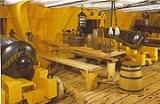
Gun deck
Encyclopedia

Deck (ship)
A deck is a permanent covering over a compartment or a hull of a ship. On a boat or ship, the primary deck is the horizontal structure which forms the 'roof' for the hull, which both strengthens the hull and serves as the primary working surface...
aboard a ship
Ship
Since the end of the age of sail a ship has been any large buoyant marine vessel. Ships are generally distinguished from boats based on size and cargo or passenger capacity. Ships are used on lakes, seas, and rivers for a variety of activities, such as the transport of people or goods, fishing,...
that was primarily used for the mounting of cannon
Cannon
A cannon is any piece of artillery that uses gunpowder or other usually explosive-based propellents to launch a projectile. Cannon vary in caliber, range, mobility, rate of fire, angle of fire, and firepower; different forms of cannon combine and balance these attributes in varying degrees,...
to be fired in broadside
Broadside
A broadside is the side of a ship; the battery of cannon on one side of a warship; or their simultaneous fire in naval warfare.-Age of Sail:...
s. However, on many smaller vessels such as frigate
Frigate
A frigate is any of several types of warship, the term having been used for ships of various sizes and roles over the last few centuries.In the 17th century, the term was used for any warship built for speed and maneuverability, the description often used being "frigate-built"...
s and unrated vessels the upper deck, forecastle
Forecastle
Forecastle refers to the upper deck of a sailing ship forward of the foremast, or the forward part of a ship with the sailors' living quarters...
and quarterdeck
Quarterdeck
The quarterdeck is that part of a warship designated by the commanding officer for official and ceremonial functions. In port, the quarterdeck is the most important place on the ship, and is the central control point for all its major activities. Underway, its importance diminishes as control of...
bore all of the cannons but were not referred to as the gun deck. The completely covered level under the upper deck was, however, still called the gun deck although it had no guns at all.
Slang
The term "gun deck" is also navy slang for fabricating or falsifying something. Some say the origin of the term dates to the practice of painting the image of cannon ports on the side of one's ship in order to present the appearance of having more guns than a ship actually does, and thereby convincing any adversary that they were outgunned, forgoing engagement. A more plausible explanation relates to midshipmen retiring to the gun deck to complete their celestial navigationCelestial navigation
Celestial navigation, also known as astronavigation, is a position fixing technique that has evolved over several thousand years to help sailors cross oceans without having to rely on estimated calculations, or dead reckoning, to know their position...
assignments of computing the ship's position three times daily following morning star sights
Star-Sighting
Star-sighting generally refers to a type of navigation which uses the position of the stars to determine direction or the observer's position. Polaris, can be used to determine North at any time of night when stars are visible in the Northern Hemisphere. Other stars can be used for navigation if...
, noon sun line, and evening star sights. While some midshipmen might be conscientious about computing positions from new observations, others were reputed to extrapolate and back calculate observation data from dead reckoning
Dead reckoning
In navigation, dead reckoning is the process of calculating one's current position by using a previously determined position, or fix, and advancing that position based upon known or estimated speeds over elapsed time, and course...
courses and speeds since earlier observations; and the actual computations performed on the gun deck were suspect.
This term is presently used to indicate the falsification of documentation in order to avoid actually doing the work or make present conditions seem otherwise acceptable.

